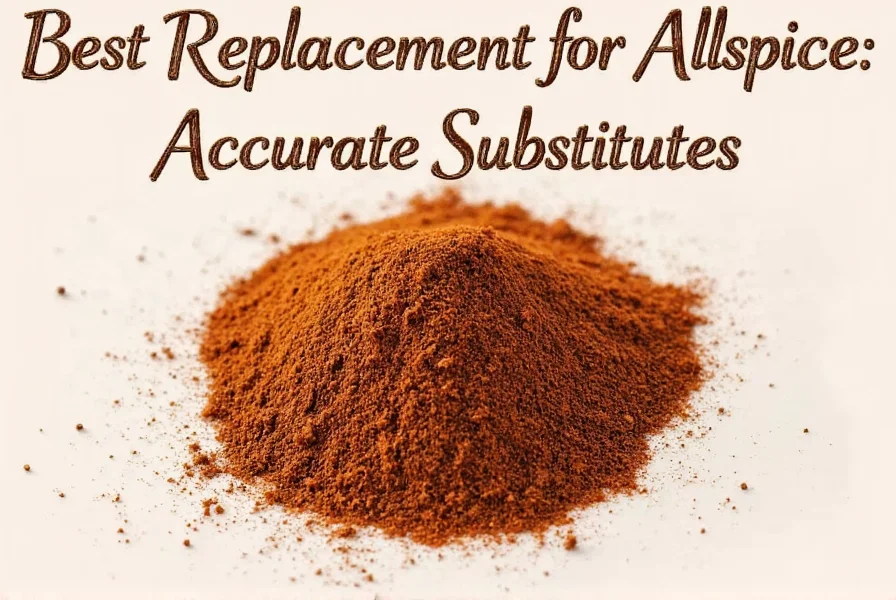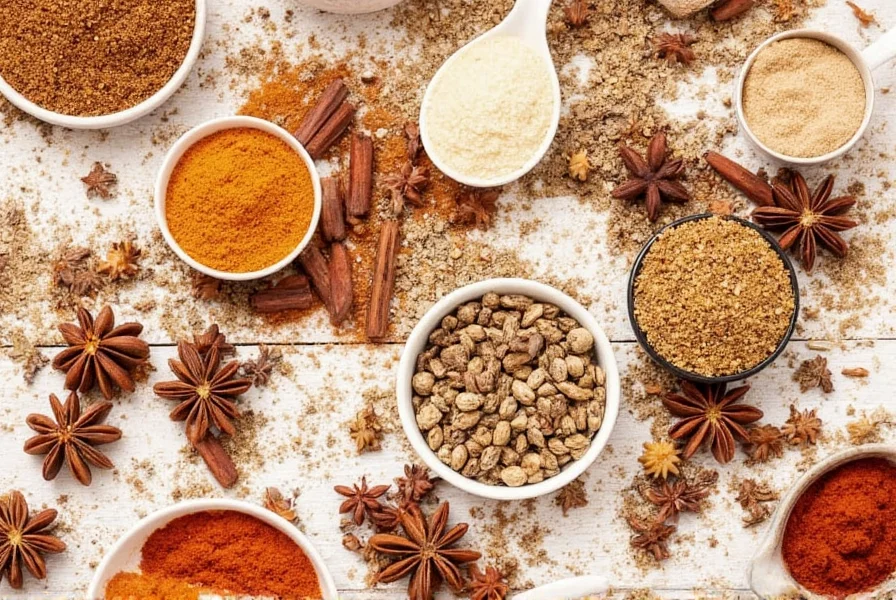The best replacement for allspice is a homemade blend of 1/2 teaspoon cinnamon, 1/4 teaspoon nutmeg, and 1/4 teaspoon cloves for every 1 teaspoon of allspice required. This combination accurately replicates allspice's complex flavor profile, which naturally combines notes of cinnamon, nutmeg, cloves, and pepper. For immediate substitution needs, pre-ground pumpkin pie spice works well in sweet recipes at a 1:1 ratio, while a 3:1 ratio of cinnamon to cloves serves as a quick alternative in savory dishes.
Running out of allspice mid-recipe can derail your cooking plans, but understanding proper replacements ensures your dishes maintain their intended flavor complexity. Allspice, despite its name, isn't a blend but a single berry from the Pimenta dioica tree that naturally combines flavors reminiscent of several spices. When seeking a replacement for allspice, the goal is to recreate this distinctive warm, sweet, and slightly peppery profile that works equally well in Caribbean jerk seasoning, Middle Eastern stews, and American pumpkin pie.
Understanding Allspice and Why Substitutions Are Needed
Allspice earned its name because early European explorers thought it tasted like a combination of cinnamon, nutmeg, and cloves. This versatile spice plays crucial roles in various global cuisines:
- Caribbean cooking (essential in jerk seasoning)
- Middle Eastern dishes (like Lebanese baharat)
- British baking (in Christmas pudding and mince pies)
- American desserts (pumpkin pie, spice cakes)
Common reasons for needing an allspice substitute include unavailable ingredients, dietary restrictions, or simply running out while cooking. The right replacement depends on whether you're preparing sweet or savory dishes, as different spice combinations work better in various culinary contexts.
Top Allspice Substitutes Ranked by Effectiveness
Not all replacements work equally well across different recipes. Here's how various substitutes perform in practical cooking scenarios:
| Substitute | Best For | Ratio (per 1 tsp allspice) | Flavor Accuracy |
|---|---|---|---|
| Cinnamon + Nutmeg + Cloves | All-purpose replacement | 1/2 tsp cinnamon + 1/4 tsp nutmeg + 1/4 tsp cloves | ★★★★★ |
| Pumpkin Pie Spice | Sweet baked goods | 1 tsp pumpkin pie spice | ★★★★☆ |
| Cinnamon + Cloves | Savory meat dishes | 3/4 tsp cinnamon + 1/4 tsp cloves | ★★★☆☆ |
| Apple Pie Spice | Fruit-based desserts | 1 tsp apple pie spice | ★★★☆☆ |
| Five-Spice Powder | Asian-inspired recipes | 3/4 tsp five-spice powder | ★★☆☆☆ |
Detailed Breakdown of Allspice Alternatives
The Classic Three-Spice Blend (Most Accurate Replacement)
For the most authentic allspice substitute, combine equal parts ground cinnamon, nutmeg, and cloves. This trio captures allspice's signature flavor profile. When making this replacement for allspice in recipes:
- Use 1/2 teaspoon cinnamon for warmth and sweetness
- Add 1/4 teaspoon nutmeg for earthiness
- Include 1/4 teaspoon cloves for pungency
This blend works exceptionally well as an allspice substitute for baking and in Caribbean dishes where authentic flavor is crucial. For the best results, toast whole spices before grinding them for maximum flavor intensity.

Pumpkin Pie Spice (Best for Sweet Applications)
When you need a quick replacement for allspice in desserts, pumpkin pie spice makes an excellent stand-in at a 1:1 ratio. Most commercial blends contain cinnamon, ginger, nutmeg, and cloves in proportions that closely mimic allspice. This works particularly well as an allspice alternative for pumpkin pie and other autumnal desserts.
For a homemade version that serves as a perfect allspice substitute for baking, mix:
- 3 tablespoons cinnamon
- 2 teaspoons ginger
- 2 teaspoons nutmeg
- 1.5 teaspoons allspice (if available)
- 1.5 teaspoons cloves
Cinnamon-Clove Combination (Savory Dish Solution)
For meat rubs, stews, and other savory applications, a simpler blend works effectively as a replacement for allspice. Combine 3 parts cinnamon to 1 part cloves to replicate allspice's warm, peppery notes without overwhelming the dish with nutmeg's earthiness.
This ratio serves as an excellent allspice substitute for meat dishes like Jamaican jerk chicken or Middle Eastern lamb stews. The cinnamon provides sweetness while the cloves add the necessary pungency that defines allspice's character in savory applications.
Recipe-Specific Substitution Guidance
The ideal replacement for allspice varies depending on your specific recipe:
For Baking and Desserts
When making cakes, cookies, or fruit pies, use either pumpkin pie spice at a 1:1 ratio or the classic three-spice blend. For delicate desserts like custards, reduce the clove content by half in your allspice substitute to prevent overpowering the dish.
For Caribbean and Jerk Recipes
The best replacement for allspice in Caribbean dishes requires the full three-spice blend. Authentic jerk seasoning relies heavily on allspice (called "pimento" in Jamaica), so don't skip the cloves in your substitute, as they provide the necessary heat component.
For Meat Rubs and Savory Dishes
When preparing meats, try a 3:1 ratio of cinnamon to cloves as your allspice substitute. This combination provides sufficient warmth without the sweetness that nutmeg might add to savory applications. For game meats, add a pinch of black pepper to your replacement for allspice to enhance the earthy flavors.
What NOT to Use as Allspice Substitutes
Certain common suggestions make poor replacements for allspice:
- Five-spice powder - Contains star anise and fennel which create an entirely different flavor profile
- Individual spices alone - Using only cinnamon, nutmeg, or cloves misses the complexity of allspice
- Garam masala - Too many additional spices alter the intended flavor balance
- Pre-mixed curry powder - Contains turmeric and other ingredients that change color and flavor
While these might work in specific circumstances, they generally don't provide an accurate replacement for allspice across most recipes.
Storage Tips for Homemade Substitutes
If you've created a batch of homemade allspice replacement, proper storage maintains freshness:
- Store in airtight glass containers away from light and heat
- Use within 3-6 months for optimal flavor (ground spices lose potency faster than whole)
- Consider making small batches to ensure freshness
- Label containers with the blend ratio for future reference
For the longest shelf life, keep whole spices and grind them as needed. This approach creates the most effective replacement for allspice when you need it, with maximum flavor intensity.

Final Substitution Tips
When implementing your replacement for allspice, remember these professional tips:
- Taste as you go - spice potency varies by brand and freshness
- Add substitutes gradually, especially in liquid-based recipes
- For marinades, let the substitute blend sit for 30 minutes before using to allow flavors to meld
- In baking, mix dry ingredients thoroughly to distribute the substitute evenly
- When substituting in large batches, scale ingredients precisely rather than eyeballing
Frequently Asked Questions
Can I use pumpkin pie spice instead of allspice?
Yes, pumpkin pie spice makes an excellent 1:1 replacement for allspice in sweet recipes like pies, cakes, and cookies. Most commercial blends contain cinnamon, ginger, nutmeg, and cloves in proportions that closely mimic allspice's flavor profile, though it may be slightly sweeter. For savory dishes, the classic three-spice blend works better.
What's the difference between allspice and mixed spice?
Allspice is a single spice from the Pimenta dioica berry, while mixed spice is a British blend typically containing cinnamon, coriander, caraway, and nutmeg. Mixed spice lacks the clove component essential to allspice's flavor, making it less suitable as a direct replacement. For most recipes, the three-spice blend (cinnamon, nutmeg, cloves) works better than mixed spice as an allspice substitute.
How do I make a quick allspice substitute without nutmeg?
If you don't have nutmeg, combine 3/4 teaspoon cinnamon with 1/4 teaspoon cloves for every teaspoon of allspice needed. For enhanced flavor, add a tiny pinch of black pepper or allspice berries if available. This works particularly well for savory meat dishes but may lack some depth in sweet applications where nutmeg's earthiness is important.
Can I use whole allspice berries as a substitute for ground allspice?
Yes, but with adjustments. Use 6-8 whole allspice berries per teaspoon of ground allspice required. Crush them slightly before adding to allow flavor release, and remember to remove them before serving. Whole berries provide more intense flavor that develops slowly, making them ideal for stews, braises, and pickling solutions but less suitable for baked goods.
Why does my allspice substitute taste different than real allspice?
Homemade substitutes may taste different due to varying spice quality, freshness, or ratios. Real allspice has a unique chemical composition that's difficult to perfectly replicate. For closer results, use freshly ground whole spices rather than pre-ground, adjust ratios based on your specific spices' potency, and let the substitute blend sit for 30 minutes before using to allow flavors to meld properly.











 浙公网安备
33010002000092号
浙公网安备
33010002000092号 浙B2-20120091-4
浙B2-20120091-4